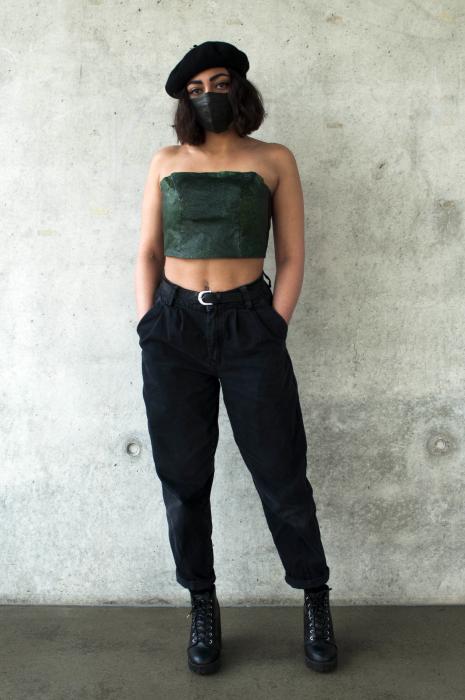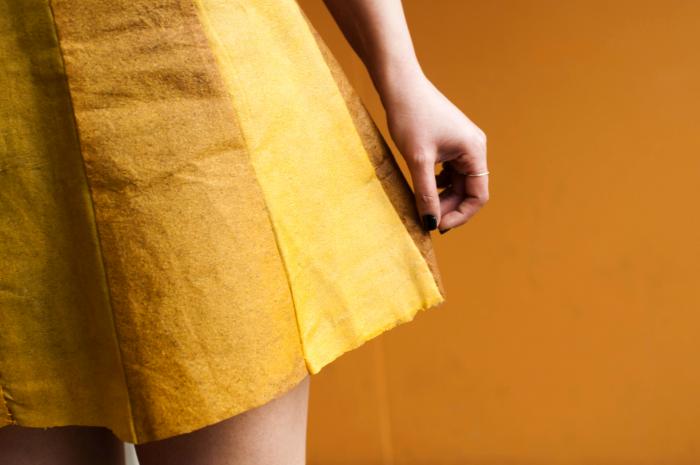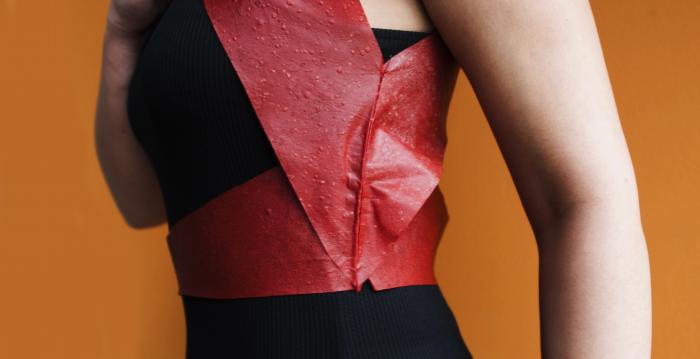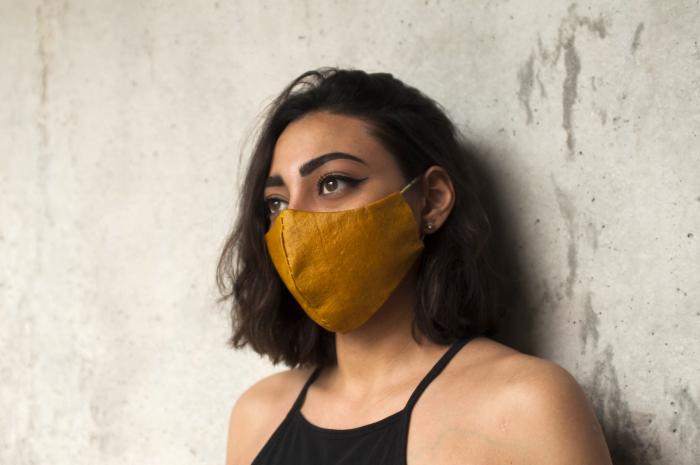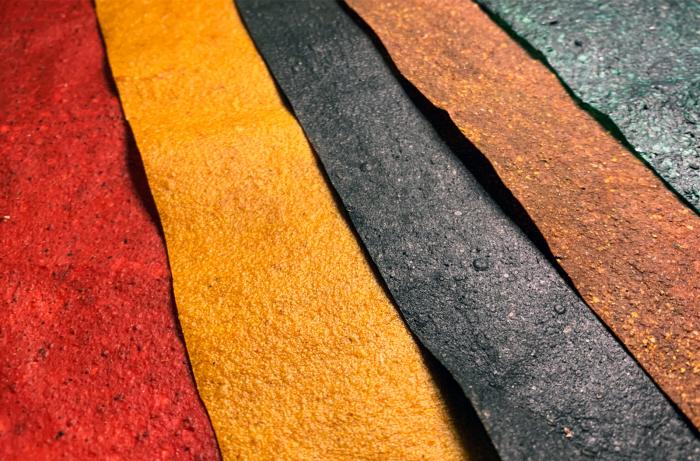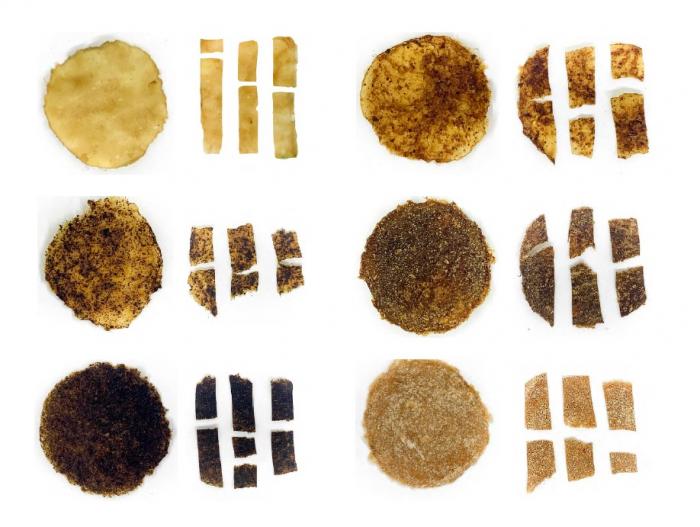I. SUMMARY INFORMATION
Project
267760
Status
Submitted
Award category
Products and life style
You want to submit
NEW EUROPEAN BAUHAUS AWARDS : existing completed examples
Project title
Microbial Leather
Full project title
Microbial Leather; The feasibility of bacterial cellulose composites as alternative bio-textiles.
Description
Bacterial cellulose is a sheet material grown on the surface of a brew, by yeast and bacteria. This material has leather-like characteristics, but has limitations. The aim was overcoming several of these such as; homogeneity in colour, and thickness and enhancing aesthetics and appeal, thus improving the workability of the material. 5 composite materials were developed and applied in the context of fashion to prove the feasibility of bacterial cellulose food waste composites as bio textiles.
Where was your project implemented in the EU?
Germany
Saxony-Anhalt
Karlstraße 33
Dessau-Roßlau
06844
When was your project implemented?
Has your project benefited from EU programmes or funds?
No
Which programme(s) or fund(s)? Provide the name of the programme(s)/fund(s), the strand/action line as relevant and the year.
II. DESCRIPTION OF THE PROJECT
Please provide a summary of your project
The feasibility of bacterial cellulose composites as alternative bio-textiles. The textile and leather industry is ever growing and well renowned for its negative environmental impacts. This project tackled this issue in the form of material innovation. If we cannot protect the public from the impacts of fast fashion, we must attempt to ensure that what they are consuming is environmentally friendly through out its entire life cycle, from production, to disposal, and everything in between.
Please give information about the key objectives of your project in terms of sustainability and how these have been met
criteria of ecological design
The materials produced are durable, due to their high strength. They are repairable due their ability to be patched easily and naturally. Bacterial cellulose as well as food waste are both biodegradable. Natural ingredients were used through out the entire process and little to no energy is required for production. It changes the narrative of fashion therefore shining a light on the dire need for sustainable materials, changing user behaviour towards the better.
environmental relief / pollution
The material composites are made by giving purpose to organic waste. The growth, production, and disposal methods, leave no room for harm to the environment. The applications of these materials would revolutionize the fast fashion industry. Changing purchase patterns globally is a vicious problem, however, if the habits cannot be changed, then the material compensates with its fast biodegradation time of 60 days, when and if the product is no longer needed.
Please give information about the key objectives of your project in terms of aesthetics and quality of experience beyond functionality and how these have been met
This project is focused on grown bacterial cellulose, a sheet material grown on the surface of a brew of tea and sugar by yeast and bacteria. Although this material has been growing more popular in the design field, it has limitations that are physical and aesthetic. The research was based on overcoming several of these such as; homogeneity in colour, and thickness and improving aesthetic and haptic diversity as well as appeal, thus improving the workability of the material. This is done through a wide array of experimentation processes such as composite growing, blending, and coating. All experiments were subject to tensile strength tests. Via the exploration of previously existing literature accompanied with new compositing techniques and tests results were gathered. From this series, 5 composite materials were developed and applied in the context of fashion in order to prove the feasibility of bacterial cellulose food waste composites as alternative biotextiles.
Please give information about the key objectives of your project in terms of inclusion and how these have been met
We live on a planet of mindless production, depleting resources, and endless waste. Which means that the balance of our biotic community is constantly being threatened. In the midst of a materialistic uproar, we are tasked with the responsibility to attempt to shift the balance back to its correct state. The textile and leather industry are ever growing and well renowned for their negative environmental impacts. This thesis tackled this issue in the form of material innovation. If we cannot protect the public from the impacts of fast fashion, we must attempt to ensure that what they are consuming is environmentally friendly throughout its entire life cycle, from production, to disposal, and everything in between. Besides the collective well being of the planet and its inhabitants, this aids in reducing the need for sweatshops as well as preserving animal life.
Please give information on the results/impacts achieved by your project in relation to the category you apply for
This project tackles the ever-growing global issue of trash accumulation, as well as attempting to reduce the negative impacts of the fashion industry such as water pollution, water over consumption, greenhouse gas emissions, microfibers in oceans, and chemical additions. It promotes sustainable consumption in the form of not only providing a feasible alternative textile, but also by shining a light of the necessity of having an alternative. The project's speculative design core impacts the industry immensely. Sustainable textiles are ever-growing in not only popularity, but also necessity. Which is slowly, but surely, changing the perception of the industry, urging them to make changes or risk losses. Pushing towards a steady paradigm shift in the narrative.
Please explain the way citizens benefiting from or affected by the project and civil society have been involved in the project and what has been the impact of this involvement on the project
A sample of those affected/benefiting from this project were periodically questioned about their appeal towards the material with reference to how it looked, felt, smelt, and behaved. These people were also interviewed about their needs and desires in terms of how and where they would like to see this material be implemented.
Please highlight the innovative character of the project
degree of innovation (from a design and environmental perspective)
This project is highly innovative environmentally, by compositing the organic waste that is produced by the fermentation of Kombucha tea (Bacterial Cellulose) as well as inevitable food loss and waste that is generated by every individual, household, and industry, into a unique composite material. The materials have undergone tensile strength test and have been applied to products, proving the feasibility of the material. Furthermore, the design innovation can be seen in the diversity of colour, texture, and general improvement of mechanical properties. Previously, the raw material, bacterial cellulose was only altered in terms of colour, however, the limitations of the material were not tackled. This project aimed and succeeded at tackling the majority of the aesthetic and functional properties of the material, making it workable and applicable in the scope of production.
Please explain how the project led to results or learnings which could be transferred to other interested parties
This project yielded data that had not been studied previously, it creates a narrative for further studies to be done with this material such as genetically modifying the yeast and bacteria that produce the cellulose to give the material different characteristics, thus being highly beneficial to the material science field. In terms of fashion, this material opens up a new era of fashion trends with a sustainable twist which all designers are aiming towards in one way or another.
Is an evaluation report or any relevant independent evaluation source available?
No
III. UPLOAD PICTURES
IV. VALIDATION
By ticking this box, you declare that all the information provided in this form is factually correct, that the proposed project has not been proposed for the Awards more than once under the same category and that it has not been subject to any type of investigation, which could lead to a financial correction because of irregularities or fraud.
Yes
